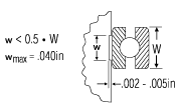As discussed, bearings are often bonded in
place with adhesive. This method also allows bearing pairs to
be preloaded with a weight to remove axial play while the adhesive
is curing. With proper design and handling, a bearing assembly
using adhesive bonds can be extremely strong. This section deals
with some of the issues involved in adhesive bonding.
Adhesive types: Most adhesives
used for metal-to-metal bonding are of the anaerobic type. These
adhesives require the absence of oxygen before curing can start.
At least one mating surface must be porous to oxygen in order
to allow absorption of oxygen from the bond. This type of adhesive
can have shear strength in the order of 2-5,000 pounds per square
inch, resulting in push-out forces of hundreds of pounds, even
for a small assembly.
There are many types of suitable anaerobic
adhesives available from several manufacturers. The specific
adhesive used will depend on the materials to be bonded and
the application itself. Information on specific adhesives is
available from its manufacturer.
Adhesive grooves: For
maximum strength, there must be a gap between mating components
of 0.002 to 0.005 inches. In order to reduce overall runout,
it is usual to design an adhesive groove in the mating surfaces
that gives sufficient clearance for bond strength and also provides
a trap for excess adhesive. The other areas of the mating surfaces
should be kept at a minimum clearance to improve runout characteristics.


